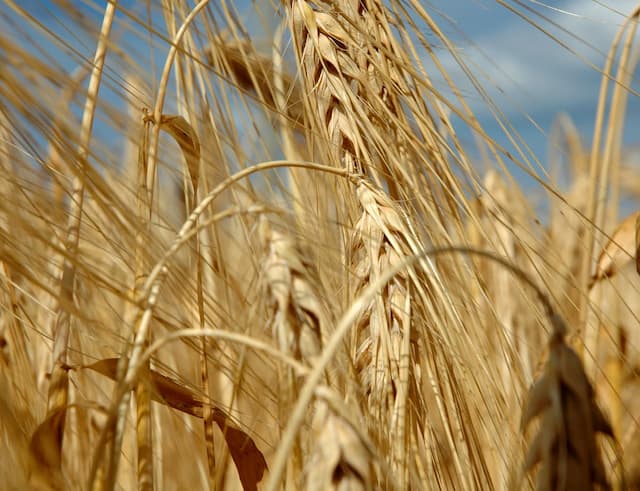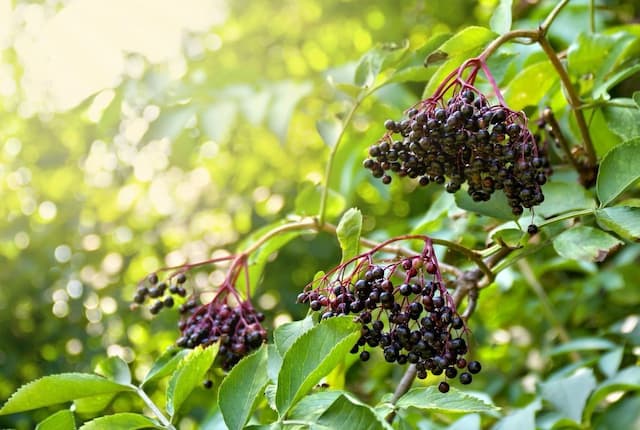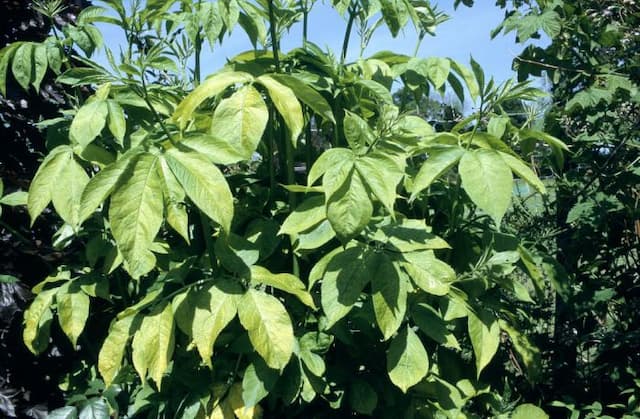Black Tower Elderberry Sambucus nigra f. porphyrophylla Black Tower = 'Eiffel 1' (PBR)
![elder [Black Tower]](/_next/image?url=https%3A%2F%2Fplants-admin.emdemapps.com%2Fimages%2Fplants%2F%2Fimages%2F604b5cad99578.png&w=3840&q=75)
ABOUT
The plant commonly known as the Black Tower Elderberry has a distinctive appearance characterized by its rich, dark leaves. These leaves have a deep purplish-black hue, lending the plant its evocative name. They are arranged in an attractive fashion, with an elongated, compound structure that adds texture to its profile. Throughout its growing season, the Elderberry produces clusters of tiny pink or creamy-white flowers. These blooms have a striking contrast against the dark foliage and can add an ornate touch to the plant's overall look. When the flowers have finished, they give way to small, dark berries that are popular with wildlife and can also be used in jams and other recipes. The plant's form is upright and columnar, giving it a striking architectural presence in the landscape. The overall color palette and structure of the Black Tower Elderberry make it a focal point in any garden setting, especially prized for its dramatic foliage and contrasting blooms.
About this plant
 Names
NamesFamily
Adoxaceae.
Synonyms
Black Tower Elder, European Elderberry Black Tower, Black Lace Elderberry Black Tower.
Common names
Sambucus nigra 'Eiffel 1'
 Toxicity
ToxicityTo humans
Elderberry, specifically the Sambucus nigra or European elderberry, has parts that are considered toxic to humans when consumed in their raw or unripe state. All parts of the plant, including leaves, stems, roots, and unripe berries, contain toxic components like cyanogenic glycosides, which can release cyanide when metabolized. Consuming these parts can lead to symptoms such as nausea, vomiting, diarrhea, dizziness, weakness, and, in severe cases, more serious effects like respiratory distress and heart problems. It is crucial to properly prepare elderberries—by cooking or other methods that neutralize these compounds—before consumption to avoid these toxic effects.
To pets
Elderberry can be toxic to pets as well. The Sambucus nigra contains similar toxic substances to those that affect humans, including cyanogenic glycosides. Ingestion of leaves, stems, seeds, roots, and unripe berries can cause poisoning in pets. Symptoms may include vomiting, diarrhea, abdominal pain, and lethargy. Severe cases can lead to more significant problems such as difficulty breathing, seizures, and even coma. It is important to prevent pets from access to this plant, especially parts that have not been treated to deactivate the toxic compounds.
 Characteristics
CharacteristicsLife cycle
Perennials
Foliage type
Deciduous
Color of leaves
Purple
Flower color
Pink
Height
6-8 feet (1.8-2.4 meters)
Spread
3-4 feet (0.9-1.2 meters)
Plant type
Shrub
Hardiness zones
5
Native area
Europe
Benefits
 General Benefits
General Benefits- Attractive Foliage: Sambucus nigra 'Black Tower' boasts deep purple-black foliage, adding dramatic color contrast in the garden.
- Architectural Structure: Its upright columnar habit creates a strong vertical element, ideal for smaller spaces or as a focal point.
- Low Maintenance: This hardy plant requires minimal care once established, making it a convenient choice for busy gardeners.
- Wildlife Friendly: The flowers attract pollinators such as bees and butterflies, while the berries provide food for birds.
- Edible Berries: It produces edible berries that can be used in jams, wines, and other culinary applications (though they should not be consumed raw and require proper preparation).
- Seasonal Interest: It offers multi-season interest with its spring flowers, summer fruits, and autumn foliage changes.
- Drought Resistance: Once established, the plant is relatively drought tolerant, reducing the need for watering.
- Adaptable: It can adapt to a wide range of soil types as long as the soil is well-draining.
- Decorative Cut Flowers: The blooms are suitable for cut flower arrangements, adding unique beauty to bouquets.
- Privacy Screen: When planted in a row, 'Black Tower' can serve as an effective privacy screen or windbreak.
 Medical Properties
Medical Properties- Immune boosting: The berries of the elder plant, to which Sambucus nigra belongs, are traditionally used to support the immune system.
- Antioxidant: Elderberries contain high levels of antioxidants, which may help protect cells from damage.
- Anti-inflammatory: Some compounds in elderberries have anti-inflammatory properties.
- Antiviral: Elderberry extracts can inhibit certain strains of influenza viruses.
- Cold and flu relief: Elderberry supplements are often used to alleviate symptoms associated with the common cold and flu.
- Diuretic: Elder flowers from the Sambucus nigra plant have diuretic effects, promoting the elimination of fluids from the body.
- Laxative: In traditional medicine, parts of the elder plant have been used to aid digestion and act as a mild laxative.
 Air-purifying Qualities
Air-purifying QualitiesThis plant is not specifically known for air purifying qualities.
 Other Uses
Other Uses- Photography Backdrop: The striking black foliage and delicate flowers of the Black Tower elderberry can create a dramatic background for portrait or macro photography.
- Insect Repellent: The leaves of the elderberry plant are believed to repel insects, so gardeners may crush them and apply them to the skin or hang bundles in outdoor areas.
- Fruit Dye: The berries of elderberry can be used as a natural dye for fabrics or paper, imparting a blue or purple hue.
- Floral Arrangements: Elderberry flowers and foliage can add a unique texture and color contrast to floral arrangements.
- Culinary Garnish: The flowers are edible and can be used fresh or dried as a decorative and flavorful addition to desserts or drinks.
- Instrument Making: Historically, the hollow stems of elderberry bushes have been used to make instruments such as whistles or flutes.
- Crafting Materials: The branches and stems can be used in basket weaving or for creating natural wreaths and other rustic crafts.
- Garden Sculpture: Pruned branches can be painted and arranged into garden sculptures or used as natural trellises for other plants to climb.
- Cooking Tool: Elderberry wood, being hard and straight-grained, has been used to make skewers and spigots for traditional casks.
- Wildlife Shelter: Dense plantings of elderberry can provide cover and nesting opportunities for birds and beneficial insects within a garden.
Interesting Facts
 Feng Shui
Feng ShuiThe Elderberry is not used in Feng Shui practice.
 Zodiac Sign Compitability
Zodiac Sign CompitabilityThe Elderberry is not used in astrology practice.
 Plant Symbolism
Plant Symbolism- Protection: Elderberries, in general, have been thought to ward off negative energy and provide protection from evil spirits in folklore.
- Healing and Health: Sambucus nigra plants have been used medicinally for centuries, symbolizing healing and the promotion of good health.
- Transformation and Renewal: The elder plant often symbolizes transformation and renewal because it can easily regenerate from damage and is one of the first plants to put out new leaves in spring.
- Wisdom: Due to its long history and many medicinal uses, the elder tree is often associated with wisdom.
- Prosperity: Some traditions hold that elderflowers bring good luck and prosperity, perhaps relating to the plant's abundant fruiting.
 Water
WaterThe Black Lace Elderberry should be watered deeply once a week, allowing the soil to partially dry out between waterings. During the growing season or in hot, dry climates, you may need to water more frequently, especially if the plant is situated in a container. A good rule of thumb is to provide about 1 gallon of water each time you water a young plant, gradually increasing to 2 gallons as the plant matures and depending on the plant size and environmental conditions. It's essential to water the base of the plant rather than overhead to minimize the risk of disease.
 Light
LightThe Black Lace Elderberry thrives in full sunlight, where it can receive at least 6 to 8 hours of direct light each day, but it can also tolerate partial shade. The ideal spot for the plant would be in an area that receives morning sunlight and partial afternoon shade, especially in regions with intense afternoon sun, to prevent foliage scorch.
 Temperature
TemperatureThe Black Lace Elderberry prefers temperate climates and can tolerate a range of temperatures. The plant is hardy in zones 4 through 7, withstanding minimum temperatures of approximately -30°F to -20°F. The ideal temperature range for optimal growth is between 60°F and 70°F during the day. However, it's quite resilient and can also survive occasional dips in temperature as well as summer highs well above the ideal range.
 Pruning
PruningPruning the Black Lace Elderberry encourages healthy growth, maintains its shape, and can enhance flowering. Prune in late winter or early spring before new growth begins, removing any dead or damaged branches as well as about a third of the oldest stems to rejuvenate the plant. It's best to prune once a year, but light trimming can be done throughout the growing season to maintain the desired shape.
 Cleaning
CleaningAs needed
 Soil
SoilBlack Lace Elderberry thrives in a well-drained, loamy soil with a pH between 5.5 and 6.5. An ideal soil mix can be prepared with equal parts garden soil, compost, and peat moss or a well-rotted organic matter.
 Repotting
RepottingBlack Lace Elderberry planted in containers may need repotting every 2-3 years or when it becomes root-bound and the growth appears to be stunted.
 Humidity & Misting
Humidity & MistingBlack Lace Elderberry prefers moderate humidity but is adaptable to various humidity conditions and does not require specific humidity adjustments.
 Suitable locations
Suitable locationsIndoor
Ensure bright light, prune to shape, pot with drainage.
Outdoor
Full sun to partial shade, well-drained soil, average moisture.
Hardiness zone
4-7 USDA.
 Life cycle
Life cycleThe life cycle of Black Lace Elderberry (Sambucus nigra f. porphyrophylla 'Eiffel 1') begins with germination, where the seeds sprout in the right environmental conditions, typically requiring stratification or cold treatment to break dormancy. The seedling stage follows, characterized by the growth of the primary leaves and development of the root system. As the plant enters the vegetative growth stage, it develops its distinctive dark purple, almost black leaves, and robust woody stems. After a few years, when mature enough, the elderberry enters the flowering stage, producing large pink flower clusters in early summer, attracting pollinators and beneficial insects. Following pollination, the flowers develop into small, black or dark purple berries during the fruiting stage, which are often used in jams, jellies, and wine, and are also valuable for wildlife. The plant then goes through a period of dormancy in the winter, where growth slows or stops until the next growing season.
 Propogation
PropogationPropogation time
Spring to Summer
Propogation: The most popular method of propagating the Black Lace Elder, which is the common name for Sambucus nigra f. porphyrophylla 'Black Tower' = 'Eiffel 1' (PBR), is through softwood cuttings. This is typically done in late spring or early summer when the plant's new growth is just starting to harden but still has some flexibility. Cuttings should be about 6 inches (approximately 15 cm) long with several leaves remaining. The lower end of the cutting is dipped in rooting hormone powder to stimulate root growth and then planted in a well-draining soil mix. To maintain humidity and encourage rooting, it's often recommended to cover the cuttings with plastic or place them in a greenhouse environment. With proper care, the cuttings will develop roots within a few weeks and can eventually be potted up individually as they mature.









